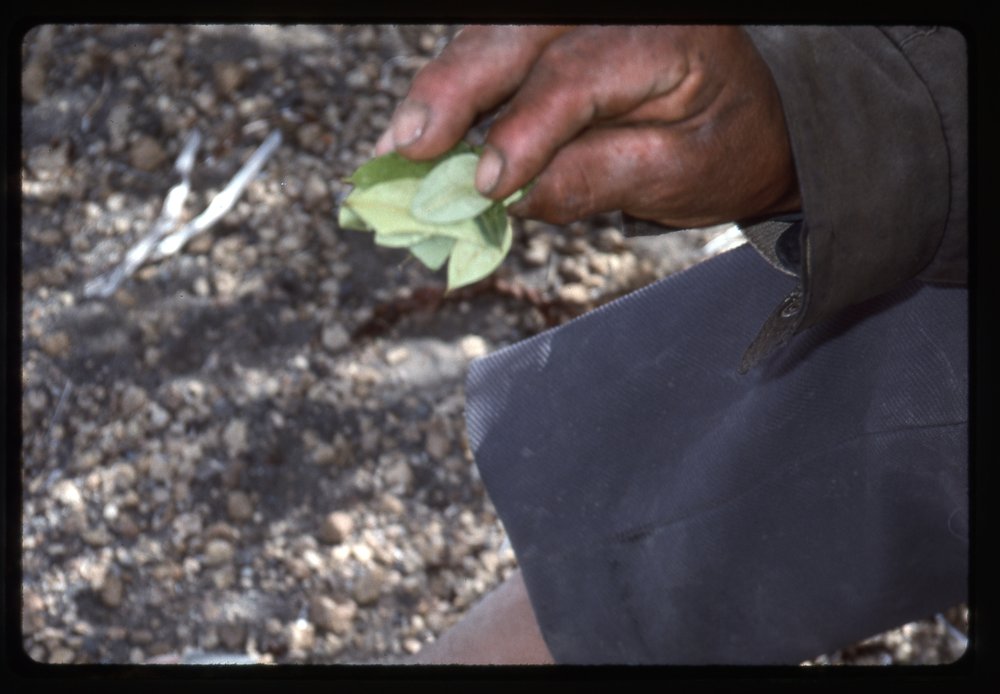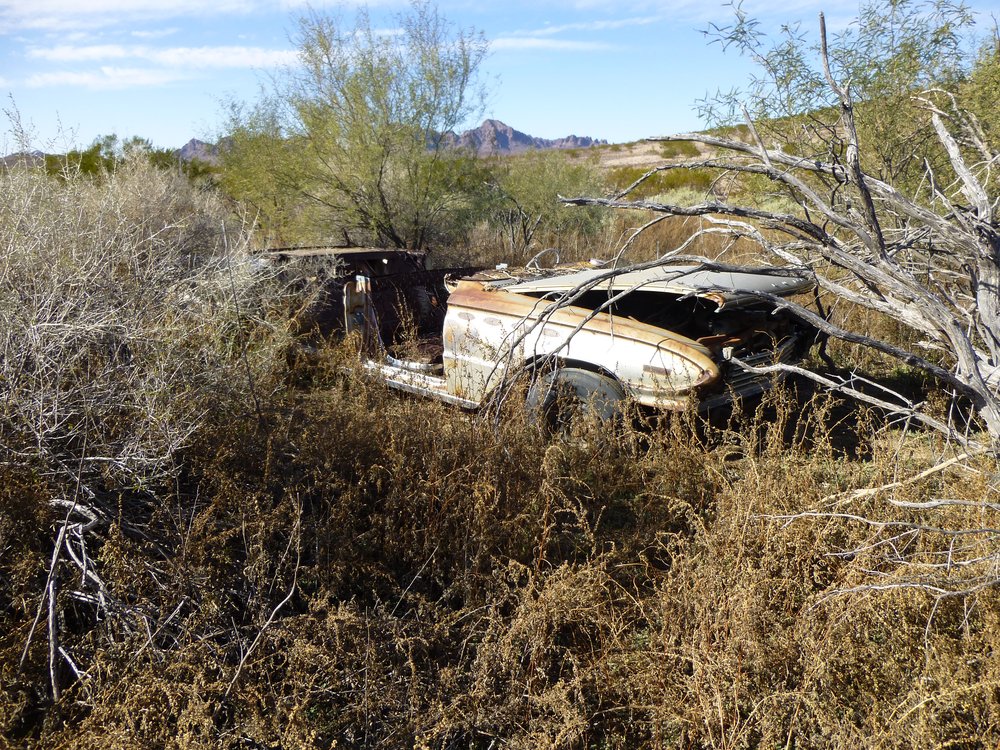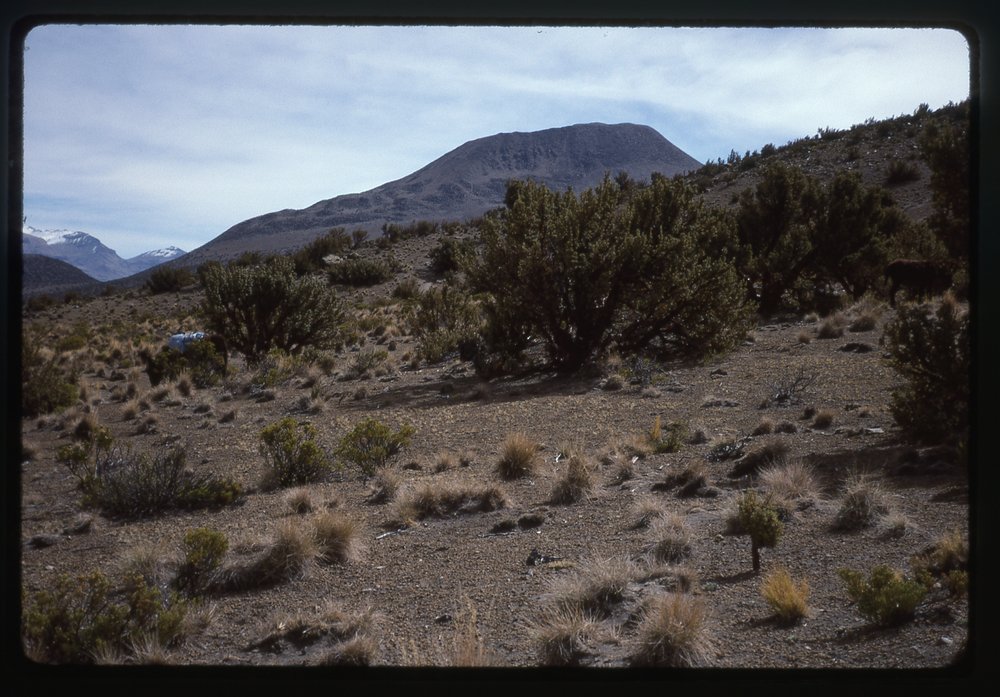Scary Rappel
We had reached the summit of this remote desert peak, and Brian had led it in grand style. Now all we had to do was to get down it in one piece. Brian set up the rappel and went down first. That way, as leader, he can check out the route and figure out our next move. I followed him. Where we stopped, I was a few feet above him. It was time to pull our rope down. It was a single rope, doubled, with no knots. and we pulled one side of it. That way, the other side would creep up the face, pass through the rappel anchor and fall down to us. Easy enough, right? It’s been done countless times. It started to pull well, then it snagged on something well above us (there was a lot of vegetation so we couldn’t see too well). So we pulled on it together, as hard as we could, and it came free, but in so doing we must have loosened up the breadbox-sized rock which came hurtling down towards us. I must have seen it coming because I yelled “Rock” and we both flattened ourselves against the wall. It missed me, then grazed the edge of Brian’s helmet and lightly glanced off his hip as it hurtled into the abyss. We were shocked and stunned – what a close call! Brian asked me if I was okay, as I did him at the same time – miraculously, we both were unscathed. Our rappel line appeared undamaged. There were 5 more messy rappels to reach an airy notch, and on the way down through all of that, I loosened a big piece of tree trunk which also missed us both, but it was another close call. It was way too much drama for one afternoon.
Coca
When Brian and I went to climb in Bolivia, we were concerned about our rapid rise in elevation and how it might affect our ability to climb. When we landed in La Paz, we found out that you could buy coca tea bags everywhere and that drinking the tea helped one adapt to high altitude. It does not cause any harm and is beneficial to health.
The coca leaf has been chewed and brewed for tea traditionally for centuries among its indigenous peoples in the Andean region. When chewed, coca acts as a mild stimulant and suppresses hunger, thirst, pain, and fatigue. It helps overcome altitude sickness. There is an increasing use of coca flour as a food supplement. The traditional method of chewing coca leaf, called acullico, consists of keeping a saliva-soaked ball of coca leaves in the mouth together with an alkaline substance that assists in extracting cocaine from the leaves. We witnessed this practice first-hand when we hired a man to transport our gear on his donkeys to a base camp for our climb. He had a pouch of coca leaves, and was always stuffing them into his mouth and chewing them.
The Buick
Over the years, I’ve seen a lot of strange sights in the desert, but one that would be at the top of the list would have to be this one.
Far out on the military bombing range, way out beyond beyond, I came across this beauty, a good 30 miles into the forbidden zone where no one was ever allowed to go. It was a 1961 Buick Electra 225, a 2-door convertible with power seats and a nifty AM push-button radio, the flagship of Buick’s sedan line. Almost certainly it had been stolen and used to evade law enforcement. It had been there a very long time, as vegetation had grown into the passenger compartment and even through the openings in the dashboard.
Leaky Tent
Many years ago I owned a tent which had been touted as state-of-the-art. It was a single-wall waterproof tent with no rainfly. They claimed it stayed dry inside due to its ventilation system at each end. Hah! Waterproof, my ass!! I’ll never forget the night Brian and I spent in it during a violent thunderstorm. We were camped in Titcomb Basin in the Wind River Range in Wyoming at 10,550 feet elevation. The storm was biblical, and the rain came in torrents so hard it threatened to blow us away. For hours, we mopped the water from the floor with a couple of T-shirts, fighting a losing battle against the storm. If it hadn’t been for our history of climbing together, we wouldn’t have taken the whole affair with the good humor we did that long night.
Climbing Deadline
Sometimes when you’re on a big climb, you need to set a turnaround time. Using your best judgement, you decide what is the latest safe time by which you absolutely must turn around and head back down the mountain so you don’t get yourself into trouble, whether you’ve reached the top or not. That could allow for certain conditions on the mountain, or so that you don’t run out of daylight.
It was 4,000 feet from camp to the summit. At 4:10 AM we left and climbed through the dark and then all day. It wasn’t until 1:45 PM that we decided on a turnaround time – 4:00 PM would be it. Well, things finished up better than we thought, and at 2:30 PM we reached 20,700 feet. It had taken 10 hours 20 minutes. After only 15 minutes on top, we started back down. It only took 3 hours and 50 minutes to get all the way back down to camp. In the tropics, darkness falls very quickly with almost no twilight, and it was dark around the time we returned. In retrospect, if we had honored our turnaround time of 4:00 PM, we would have been benighted high up on the mountain. This was before there was GPS, so it would have been dodgy indeed, possibly forcing an unplanned bivouac out in the open.
Old Blue
About 430 miles east of New Zealand is a small group of islands known as the Chatham Islands – they are a part of New Zealand. On one of them, it was discovered in 1968 that there was a small group of a bird known as the Chatham Island black robin. There were about 30 of them, all living on 15-hectare Little Mangere Island, which fortunately was predator-free. This was the only population of these birds, making their species perhaps the rarest in the world.
By 1973, the population had dropped to only 18 birds; by 1975, only 11.The next year, there were only 8 surviving, and by 1977, only 5. That tiny group included only one breeding pair. Scientists were alarmed. They devised a carefully-monitored program to handle eggs and chicks. The only breeding female was given the name “Old Blue” from the color of her leg band. Normally, the life span of these birds is 4 years in the wild. Old Blue was already twice that age. By 1982, the population had increased to 12 birds, and Old Blue was the mother of all of the new ones. In her geriatric years, Old Blue and her mate Old Yellow produced 6 chicks. Old Blue was last seen on December 13, 1983. That little bird was the savior of her race. She hung on to life until the age of 14 years – it was as if she knew that she had to, in order to keep the chances of her species alive. They now number about 250 birds. The New Zealand Parliament honored Old Blue in their proceedings, a nation grateful for her contributions to save her species.
The Highest Trees
There is a tree that grows in the Andes Mountains of South America, a tree that botanists say grows higher than any other tree in the world. It is called the queñua by locals and has the scientific name Polylepis rugulosa. When we camped on the shoulder of Nevado Sajama at 15,370 feet elevation, they were all around us. We saw them growing higher, in places close to 17,000 feet
Brazeau Loop
In the heart of the Canadian Rockies is a really nice 5-day backpack trip called the Brazeau Loop. The entire distance of 51.1 miles is all done on trails, and it passes through some splendid country. It starts at a parking area along the Icefields Parkway at around 6,150 feet elevation and heads generally north from there. It does in fact describe a loop, and ends back where you started. It is considered to be fairly challenging, and in the course of those 51 miles reaches a maximum elevation of 8,325 feet. There are campsites at comfortable intervals along the way, and if you take the full 5 days you only need to do an easy 10 or so miles each day. The entire loop entails an elevation gain of almost 10,000 vertical feet.
John and I had lucked out with the weather and hadn’t been rained on the entire trip. By the time we returned to the parking lot, our starting point, we were glad to be done, a bit footsore but otherwise feeling happy that we had finished the whole thing. There was only one other car there as well as ours, and beside it two lovely young ladies were preparing their backpacks. They struck up a conversation with us, asking us questions about the trip and how it had all gone. Then out of the blue, they shocked us by asking if we would be willing to do the entire trip over again as their companions with benefits. They said they’d feel safer being with a couple of cute guys, that it would be a lot more fun as a foursome, and that the nights wouldn’t feel so cold and lonely if we were there with them. This was back in an era when such things were commonplace. Although we weren’t too excited about repeating the 50 miles, to do it under these circumstances was incredibly tempting. Did we join them? I’ll let you use your imagination.
Snowy August
It was late August. George and I had spent the weekend climbing near Jasper and were on our way back to Golden. The weather had turned foul and we felt it even more because we were on my motorcycle. Yes, we had raingear of sorts, but I don’t care how good your gear is, if it’s cold and a wet snow is falling, you’re going to be miserable. We pulled off at a roadside shelter, just a place with a roof and a couple of tables but otherwise open to the elements. There was a family there, making the best of things. There was a barbeque grill, and they had just cooked some chicken. They offered to share it with us, and nothing had ever tasted so good. We relished every bite as the snow fell only a few feet away.
Nervous Grandma
I had done a lot of hitch-hiking in the summer of 1965, as I had no wheels of my own. That was okay, though, because back then it was easier to get around that way – people weren’t so afraid of picking up strangers. Before I returned to university, one last trip seemed in order. My aunt and her family lived in Medicine Hat, Alberta, about 350 miles from where I was living at the time. I had written to them, asking if I could come and visit, as I had never met her family, and received a warm invite. So, on the Saturday of a long weekend, I started hitching in the rain. After a series of excellent rides, I had covered the entire distance in 6 1/2 hours.
My grandmother lived in a nearby village called Seven Persons (honest, I’m not making this up – it’s a real place on the map). Before that, she had lived in Manyberries, a bit farther down the road. She came up to my Aunt’s place, and we all had a nice visit that weekend. However, Grandma was mortified that I had hitch-hiked to get there. She pressed some cash on me and we went to the train station where I bought a coach seat for the trip back to my town. On Monday morning, I rode in comfort. It was effortless, but it did take 9 hours, a lot longer than my hitch-hike journey of a few days earlier.




